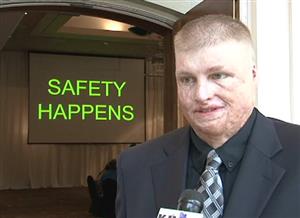Safety Happens

PO1, Michael K. Lammey, Ret.
On an ordinary day in December 2006, under what seemed to be ordinary circumstances, “Safety Happens” was forged in the 720 degree steam and heat of a boiler explosion aboard the USS Frank Cable, Guam. PO1 Michael Lammey was burned over 56% of his body with 3rd degree burns. He decided during the four years following the accident, and after going through 50+ surgeries and thousands of rehabilitation hours, that enough was enough. The explosion affected six seamen and their
families, with two fatalities in its wake. Michael experienced first-hand the toll of the explosion, and the effect it had on his and his shipmate’s family and friends.
He slowly began to understand his life was meant for a definite purpose, and he and his family began organizing resources to meet that purpose. As he defines it, his company, Safety Happens, exists to educate organizations and their safety team members who work in high pressure, dangerous vocations that safety does matter. Every person who leaves for work should expect to return home in good health. Unsafe working conditions affect service delivery quality and worker productivity and retention. Safety should be viewed as an integral part of human resources management systems – hazardous environments
increase absenteeism, turnover, risk of abandoning the profession, short-term sick leave, longer-term disability, and even death. For an organization already suffering safety issues, there is risk of additional accidents, as the workers who remain have an increased risk of physical and emotional harm as they try to navigate the workplace to provide coverage.
If a worker is injured on the job, the company loses – lost work hours, increased insurance rates, worker’s compensation premiums, and possible litigation – as well as dealing with workers who respond to the injured worker. They may end up distracted or needing time off to deal with the aftermath - a single injury can have debilitating effects on an organization. The worker loses – income, physical and emotion distress dealing with their injury, resources stretched to the breaking point, substantial time demands on family members – human loss and suffering is immeasurable.
Michael’s injuries are not a result of a safety protocol violation. His injuries can be directly attributed to complacency backed by a false sense of security. He began to recognize that when people routinely perform repetitive and dangerous tasks, it is very easy to become desensitized to the inherent risk of what could happen, and what also could happen after a risk becomes a reality. The two factors alone - complacency coupled with a false sense of security can and do produce catastrophic results.